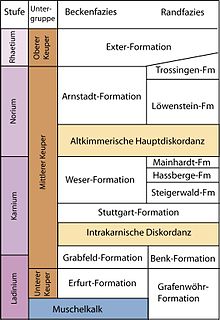Erfurt Formation
| Erfurt Formation | |
|---|---|
Stratigraphic range: | |
 | |
| Type | Geological formation |
| Unit of | Lower Keuper |
| Underlies | Grabfeld Formation |
| Overlies | Upper Muschelkalk |
| Thickness | 20 to 700 m.[1] |
| Location | |
| Coordinates | 50°56′57″N 11°04′12″E / 50.949036°N 11.070136°E |
| Region | Mittelgebirge, North German Plain |
| Country | Germany |
| Type section | |
| Named for | Erfurt |
| Named by | Hoffmann, 1830 |

The Erfurt Formation is a stratigraphic formation of the Keuper group and the Germanic Trias supergroup. It was deposited during the Ladinian. It lies above the Upper Muschelkalk and below the Middle Keuper.[1]
Definition
The formation was defined in Erfurt-Melchendorf in 1830 by the late Franz Xaver Hofmann and named for the nearby town of Erfurt.[1]
The Erfurt Formation is underlain by the Upper Muschelkalk. The lower boundary to the Erfurt Formation is the "Lettenkohlensandstein" in northern Germany and the "Grenz-bone-beds" in southern Germany.
The formation is a sequence of dolomite, lacustrine limestones, claystone, evaporites, and fluviatile sandstones. The color is usually grey but can also be brown or reddish brown. The average thickness is 60 to 80 meter, with a maximum thickness of 700 meter in the Glückstadt-Graben.[1]
The upper boundary is marked by dolomites, or claystones of the Grabfeld Formation.[1]
Fossils
The Erfurt Formation is known for its vertebrate fossils. Different kinds of fish, amphibians and dinosaurs have been found. Usually they are found as bone beds, but in 1977 the first complete skeletons were found near Kupferzell. They include Mastodonsaurus, Gerrothorax, Plagiosuchus, Callistomordax, Nanogomphodon, Batrachotomus, Kupferzellia and Palaeoxyris friessi.[2]
References
- ^ a b c d e "Erfurt Formation". BGR. Retrieved 2 March 2013.
- ^ Ronald Böttcher (2010). "Description of the shark egg capsule Palaeoxyris friessi n. sp. from the Ladinian (Middle Triassic) of SW Germany and discussion of all known egg capsules from the Triassic of the Germanic Basin" (PDF). Palaeodiversity. 3: 123–139. Retrieved 23 January 2012.
